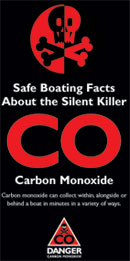Safety
Carbon Monoxide (CO)

Carbon Monoxide poisoning can be deadly, hence CO’s nickname, “Silent Killer”. I find that most boats in my area do not have marine quality, marine UL-listed, detectors installed and if they are, often times they are disconnected.
And when I test detectors I find that they have been disabled by owners that they were tired of getting “false” signals.
I’m not sure how they can make that assessment since carbon monoxide is not detectable by sight, smell, or any other means by the humans. The only way to know if there is a CO problem is by using a CO tester and/or a marine quality, marine UL-listed detector. It has also been reported by some folks that the CO detectors send “false” signals when upholstery and other boat building materials are out gassing. While there may be a sliver of truth to that, it seems counter-productive to just disconnect the detector because it is making too much noise. What ever the cause of the detector signaling danger, the source of the problem must be located and repairs made.

CO Facts
- Carbon Monoxide (CO) is a colorless, odorless, tasteless, toxic gas produced during the incomplete combustion of fuel, including gasoline, diesel, propane, CNG, charcoal, kerosene, wood, etc.
- Contrary to popular belief, diesel fuel produces CO.
- Any carbon based material that is burned produces CO.
- CO poisoning and sea sickness symptoms are very similar – Don’t let people tap a nap below while the engine, generator or nearby engines are operating without proper and adequate ventilation and a properly operating CO detector.
- Your boat may not even have an engine but the boat owner next to you that operates his engines in the slip is producing CO that most likely will enter your boat – Engine or not, install a CO detector.
- Do not assume any alarm from the detector is a “false” alarm – find out why the detector is sounding the alarm!
- Human circulatory system
CO POISONING SYMPTOMS
- Nausea
- Fatigue
- Vomiting
- Confusion
- Death
CO EXPOSURE LIMITS
Here is what the “parts per million” concentrations of carbon monoxide mean to your health:
| 100 ppm | .01% | Slight headache in two to three hours |
| 200 ppm | .02% | Slight headache within two to three hours |
| 400 ppm | .04% | Frontal headache within one to two hours |
| 800 ppm | .08% | Dizziness, nausea, and convulsions within 45 minutes. Insensible within two hours. |
| 1,600 ppm | .16% | Headache, dizziness, and nausea within 20 minutes. Death in less than two hours. |
| 3,200 ppm | .32% | Headache, dizziness and nausea in five to ten minutes. Death within 30 minutes. |
| 6,400 ppm | .64% | Headache and dizziness in one to two minutes. Death in less than 20 minutes. |
| 12,800 ppm | 1.28% | Death in less than three minutes. |
HOW TO TREAT SUSPECTED CARBON MONOXIDE POISONING
- Evacuate, Ventilate, Investigate, Take Corrective Action – Those are the basic steps. Move the affected person to fresh air. Administer oxygen if available. Contact medical help. If the person is not breathing, perform artificial respiration as taught in Cardiopulmonary Resuscitation Training until medical help arrives. Ventilate the area. Investigate the source of carbon monoxide and make repairs.
CO SOURCES
- Any engine or appliances that burns carbon based fuels – Gasoline, Diesel, CNG (Compressed Natural Gas), LPG (Propane).
- Portable generators.
- Cabin heaters that burn diesel, wood, charcoal (highest concentrations of CO), LPG (Propane).
- Unventilated and non-marine instant type water heaters.
LOCATIONS OF POSSIBLE HIGH CONCENTRATIONS OF CO
- At helm and below deck when operating at slow speed and the cockpit, he;m, and interior have a low pressure which draws in exhaust fumes and CO.
- Swim platforms.
- Cockpits.
- Engine rooms.
- Generator spaces.
- Interior cabin spaces especially near engine compartments.
- When your moored or at anchor.
PREVENTION
- Install marine quality, marine UL-listed, carbon monoxide detectors in the accommodation spaces in your boat.
- Operate your engine room ventilation blower when idling or moving at slow speed.
- Provide adequate ventilation to the boat interior spaces.
- Do not run your engine(s) at the dock for prolonged periods of time. This is especially important when the boat engines are not warmed up or require tune-ups.
DETECTORS
Marine Quality, Marine UL-listed CO detectors are specifically made for the marine environment. The conditions that the detectors are made to operate in are often times, damp, humid, stuffy environments and as such have special sensors that can deal with such conditions. Conversely, household type detectors are for the fairly stable conditions found in most homes.
Please educate yourself about the dangers of this “Silent Killer”. And do install marine quality, marine UL-listed carbon monoxide detectors in your boat and home.


Comments on this entry are closed.